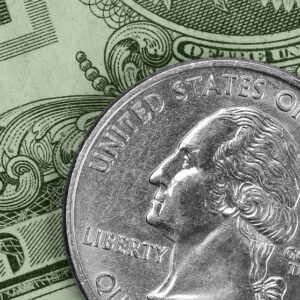Have you looked at the change in your pocket recently? You may have spotted something new on a familiar coin. Some say it rights an old wrong. Others say there never was a wrong in the first place. Read the evidence and decide for yourself.
Americans pride themselves on being master practitioners of innovation and change. Yet when it comes to our coinage, we’re downright stodgy. The Lincoln penny is a beloved childhood memory for many, but at 114 years, the obverse (the front) also holds the world record for the longest-running coin without a change. Likewise, the dime is 77 years old, and the half-dollar is practically a kid at 59. (They’ve tinkered so much with the nickel in recent years, we’ll sidestep that one.)
Then there’s the quarter. For 91 years, it has featured George Washington staring off into the distance with a paternalistic firmness that befits the Father of Our Country. All that time, he was looking to his left. Until last year.
Our story begins in the early 1930s. With the bicentennial of Washington’s birthday approaching, Congress thought it would be nice to mark the occasion with a special coin. The original idea was to put him only on the half-dollar for the 200th birth anniversary in 1932. But that proposal quickly grew into a complete overhaul of the quarter.
Everyone agreed George’s mug should be featured on the new 25-cent piece. And that was about all they agreed on. The George Washington Bicentennial Committee held a competition and selected a likeness crafted by sculptress Laura Gardin Fraser. She was an old hand at creating lovely coin designs, including the special Alabama Cenntenial, Fort Vancouver Centennial and Oregon Train Monument commemorative half-dollars in the 1920s. She based her creation on a famous 1785 bust of Washington done by French artist Jean-Antoine Houdon. The committee loved it and selected her design.
The venerable Commission on Fine Arts gave Fraser’s selection its blessing. And that should have been the end of that.
But it wasn’t. The design was forwarded to Treasury Secretary Andrew Mellon for his approval. Jaws dropped when he rejected Fraser’s submission and picked another designed by John Flanagan instead. It was also based on Houdon’s bust but had Washington looking the other way. Mellon’s successor as treasury secretary, Ogden Mills, stuck with the choice.
And so millions upon millions of coins showing Washington gazing to the left began rolling out of U.S. mints starting on Aug. 1, 1932.
So, why the change? The simple answer is that we just don’t know for sure. There was grumbling at the time, and it was passed down over the decades, that Mellon rejected Fraser’s submission because she was a woman. But there’s a problem with that: There is no record of Mellon writing or saying anything of the kind or having a bias against women in general.
More than likely, he probably spotted some detail he just didn’t like in the design. Mellon was an internationally recognized art connoisseur with the bankroll to support his good taste. A scion of Pennsylvania’s fabulously wealthy Mellon family, he later proposed the creation of — and backed it up by donating dozens of priceless pieces to — the National Art Gallery in Washington.
As America slogged its way through the Great Depression and World War II, the Fabulous Fifties and Swinging Sixties, right through the dawn of the new Millennium, Washington was there every step of the way, always looking left. Until the Circulating Collectible Coin Redesign Act of 2020 came along. It not only authorized the American Women Quarters program but also required that Washington remain on the front, though redesigned to look different from previous coins.
And so Frasier’s 1931 design was hauled out of storage, dusted off and finally went into production in 2022. It took 89 years, but she finally made it. Supporters say it is fitting that an obverse designed by a woman is now on a coin whose reverse honors accomplished American women.
There is a final irony, one that nobody talks much about. When the infant country was preparing to mint its very first coins in the early 1790s, Washington and Congress felt strongly that they should not bear the likeness of presidents, generals or other prominent living people. Too royal, too much like a monarchy, they said, where images of kings and queens often adorned coins, paper money and stamps. They felt so strongly about it; in fact, the practice remained in place for 120 years until Lincoln popped up on the penny in 1909.
And nobody cared which way Abe was looking.

